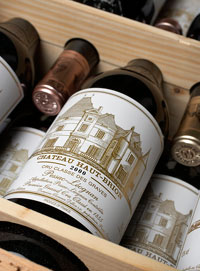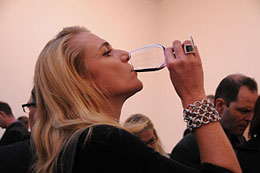|
A BURGUNDY MAN AT HEART
“My love, my heart, is in Burgundy,” said Johnny Goedhuis, chief executive of wine merchants, Goedhuis & Co, admitting to his own personal preference.
His company has been supplying good wines since he established it some 30 years ago, concentrating upon the upper end of the market and upon wines from the old  world rather than the new. world rather than the new.
“We concentrate upon what we can do properly, which is France and Italy. We’re weak on Spain, which we need to look at, but we don’t do the New World wines. It requires just too much time, travelling to these countries. And we like specialising on the old world.”
So 80-90 per cent of the Goedhuis wines are from France, and with some modesty he claims that they have “one of the strongest red burgundy lists in the country”.
A tall, charming man of the sort that the wine trade seems to attract, he owes an early appreciation of wine to his Dutch father, a serious connoisseur of claret. “We drank very well at home,” he says, “ and then I was sent off to Bordeaux to learn French, and from there it seemed inevitable that I would go into the wine business.”
A gentleman’s wine merchant in the past was as important, perhaps rather more important, than his tailor, helping to keep his cellar, or the cupboard under the stairs, up to scratch. Local merchants knew  their customers. their customers.
But now the likes of Berry Bros & Rudd, established in 1678, and Corney & Barrow (1780 and with whom Goedhuis embarked on his career) have been joined by many others eager to cater for the ever growing demands of British wine drinkers. Selecting one best suited to supplying more discerning and sophisticated taste is a matter that requires no little application and personal recommendations.
Application here is an enjoyable task. Goedhuis puts on wonderful tastings at such venues as the Saatchi Gallery in Chelsea, where the breadth of their listings and the variety of their customers is to be seen.
Above, a case of Chateau Haut-Brion. Below, sampling one of many fine wines at the tasting held at the Saatchi Gallery.
“Our growers really love coming to these events,” Goedhuis explained, “as they see that we have plenty of young customers as well as older ones, young women as well as men. In the past, it used to be thought that vicars and doctors were wine buffs. Now, it is all sorts of people.”
He makes three major buying trips a year and says the fun is in finding new wines that can be sold at a reasonable price – but it is more and more difficult to find  little family-run vineyards. He sees less interest in expensive white wines in the UK but growing demand for the expensive reds. And sales of rosé are better than they have ever been. little family-run vineyards. He sees less interest in expensive white wines in the UK but growing demand for the expensive reds. And sales of rosé are better than they have ever been.
Interest in red Burgundy particularly has exploded recently as collectors
throughout the world search for rarities, with the result that prices have soared and will continue to do so, according to Goedhuis. "Anyone with top red Burgundies has recently made substantial paper profits, if they were tempted to realise them."
Whilst acknowledging the convenience of screw tops for white and rosé wines, he is not convinced they can be right for grand reds. “ The cork is part of the ritual. I don’t think it could ever be acceptable for a Chateau Lafite to have a screw top or to come in a box!” And he points out that the rise of the screw has had a detrimental effect upon the cork industries of Spain and Portugal (see note below)
The growing wine markets in Asia, particularly China, are having an increasing effect upon wine sales worldwide, and Goedhuis now has a branch in Hong Kong. “The Chinese are learning fast and it is already a very important market for us.” More on the rise and rise of the Asian market in Savile Row Style Magazine in June.
Information not only on their wines but also on storage, courses and selling wines is to be found on the Goedhuis & Co website www.goedhuis.com.
UNCORK A BOTTLE AND HELP SAVE THE EURO
CORK is the most environmentally friendly wine stopper in comparison to other alternatives, according to carbon footprint studies. Most of it comes from forests in Portugal (about 50%), Spain (about 30%) and Italy (about 5%).
It comes from the Cork Oak, a tree which lives around 200 years. Only when a tree has reached 25 years does it start to be harvested, cork then stripped from its bark every 10 years.
As well as being environmentally friendly, natural cork stoppers allow oxygen to interact with wine to give proper ageing, making them particularly suited for red wines that are to be kept and aged. And there has been something of a swing back to corks after early enthusiasm for screw tops, with around 60 % of bottles now corked.
Other plus points are that the cork oak forests provide habitat for many endangered species, not to mention revenue for the hard-pressed economies of Portugal and Spain.
So enjoy the ritual – and uncork a bottle.
|